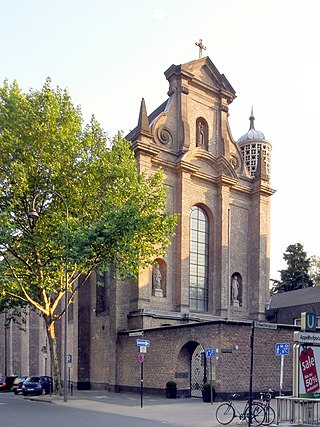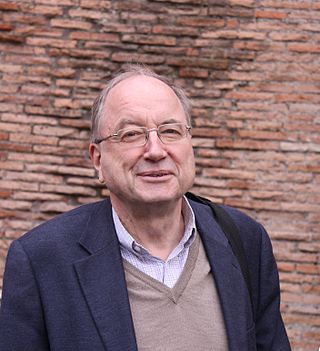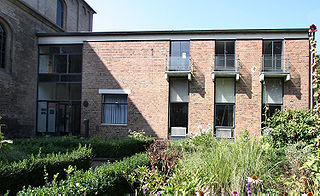Related Research Articles
Gerhard M. Koeppel was a German-born historian of Roman art and a specialist in the study of Roman historical relief sculpture. Koeppel studied at the University of Cologne and under the ancient art historian Heinz Kähler. Gerhard Koeppel was a member of the Archaeological Institute of America, the Classical Society of the American Academy in Rome, the Deutscher Archäologenverband, and Corresponding Member of the Deutsches Archaeologisches Institut. He was Resident Scholar at the American Academy in Rome (1974–1975), Professor-in-Charge of the Intercollegiate Center for Classical Studies in Rome, and Director of the American Academy Summer School (1986–1988). He joined the faculty of Classics at the University of North Carolina at Chapel Hill in 1969 and was professor emeritus at the time of his death.

Colonia Claudia Ara Agrippinensium was the Roman colony in the Rhineland from which the city of Cologne, now in Germany, developed.
Jochen Bleicken was a German professor of ancient history.
Quintus Tineius Rufus, also known as Turnus Rufus the Evil in Jewish sources was a senator and provincial governor under the Roman Empire. He is known for his role unsuccessfully combating the early uprising phase of the Jews under Simon bar Kokhba and Elasar.
Christian Habicht was a German historian of ancient Greece and an epigrapher in Ancient Greek.

St. Maria in der Kupfergasse is a Baroque church in Cologne, western Germany, in the district of Innenstadt. The pilgrimage church is dedicated to St. Mary, the Black Madonna. It was completed in 1715 and measures 37.20 meters in length and 17.30 metres in width.
Paul Zanker is the professor of Storia dell’Arte Antica at the Scuola Normale Superiore in Pisa. Previously Zanker was professor of classical archaeology at the University of Munich (1976–2002) and the University of Göttingen (1972–1976). He is a noted expert on Roman art and archaeology and a member of the Bavarian Academy of Sciences, corresponding Fellow of the British Academy, of the Academia Europaea, of the Royal Danish Academy of Sciences and Letters, the Pontifical Academy of Archaeology and of the German Archaeological Institute. From 1990 to 1991 he was the Sather professor of the University of California at Berkeley. Zanker is head of the German Commission for the Corpus Vasorum Antiquorum.

The Ara trium Galliarum, or ‘Altar of the three Gallic provinces’, was a Roman sanctuary near Lugdunum. The altar was consecrated to the goddess Roma and Augustus.
Hartwin Brandt is a German ancient historian.
Werner Huß is a German ancient historian.

Henner von Hesberg is a German classical archaeologist.
Robert Malcolm Errington, also known as R. Malcolm Errington, is a retired British historian who studied ancient Greece and the Classical world. He is a professor emeritus from Queen's University Belfast and the University of Marburg.
Egon Boshof is a German historian. From 1979 to 2002, he held the Chair for Medieval History at the University of Passau.
Dieter Nörr was a German scholar of Ancient Law. He studied at the Ludwig Maximilian University of Munich from 1949 to 1953. After receiving his doctorate with a dissertation on criminal law in the Code of Hammurabi, Nörr undertook postdoctoral study at the University of Heidelberg and the University of Rome. He worked for a year as a post-doctoral assistant at the Institute for Criminal Law and Legal Philosophy under Karl Engisch. He received his Habilitation at the University of Munich, under Professor Wolfgang Kunkel, in 1959 with a work on Byzantine Contract Law and was promoted to Privatdozent. He then accepted the Chair of Roman and Civil Law at the University of Hamburg. In 1960, Nörr became Full Professor at the University of Münster. After he declined positions at the Universities of Hamburg, Tübingen, and Bielefeld, he returned to the Ludwig Maximilian University of Munich as Professor, Chair of Roman Law, and Director of the Leopold Wenger Institute for Ancient Legal History and Papyrus Research. His brother, Knut Wolfgang Nörr, was also a Professor of Legal History, especially Canon Law, at the University of Tübingen.
The Ara Ubiorum was a Roman sanctuary in the Oppidum Ubiorum. It was erected in the last decade of the 1st century BC and was dedicated to the goddess Roma and the Roman emperor. It was a central location for the Germans conquered by Augustus to demonstrate their loyalty to Rome and the Emperor through offerings. Like the Ara trium Galliarum, the altar was the site of the concilium provinciae for the planned province of Germania Magna. The priests who serviced the altar were drawn from high-ranking Germans.
Titus Curtilius Mancia was a Roman senator, who held several offices in the emperor's service during the middle of the first century. He was suffect consul in the nundinium of November to December 55 as the colleague of Gnaeus Cornelius Lentulus Gaetulicus. No other senator with his gentilicium is known, so Mancia seems to have been a homo novus.

The Förderverein Romanische Kirchen Köln e. V. is a German association which financially and conceptually supports research, restoration and preservation of Romanesque churches in Cologne. It was founded in 1981 and also organises public relations, guided tours and lectures to improve public awareness of these churches. Günter Heidecke was one of its founders and also acted as its chairman until 2002.
Anna Maria Adele Rautenstrauch, née Joest was a German patron and benefactor. She donated the inherited ethnological collection of her brother Wilhelm Joest, which still forms the basis of the Rautenstrauch-Joest Museum, to the City of Cologne.

Karl Friedrich Heinrich Band was a German architect.

Arnold Wolff was a German architect. He was Cologne Cathedral Master Builder and head of the Dombauhütte of the Cologne Cathedral from 1972 to 1998. From 1986 to 1997, he was academic teacher for restoration and conservation at the Cologne University of Applied Sciences.
References
- ↑ Eck, W. (2007) The Age of Augustus. 2nd ed. Oxford: Blackwell, cover notes. ISBN 978-1-4051-5149-8
- ↑ Eck, Werner, “The Bar Kokhba Revolt: The Roman Point of View,” JRS 89 (1999), pp. 76-89